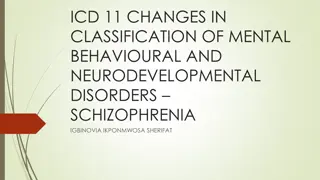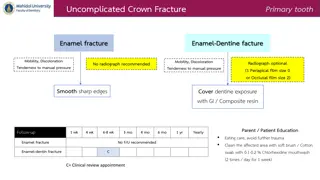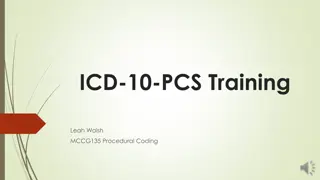Root Operations in ICD-10-PCS for Body Part Procedures
An overview of root operations in ICD-10-PCS related to taking out solids, fluids, or gases from a body part, including Drainage, Extirpation, and Fragmentation. Each root operation has specific definitions, examples, and explanations for procedures involving removal or manipulation of solid matter in the body. These operations play a crucial role in various medical interventions, such as draining fluids, excising foreign bodies, or fragmenting calculi. Understanding these root operations is essential for accurate coding in medical procedures.
Download Presentation

Please find below an Image/Link to download the presentation.
The content on the website is provided AS IS for your information and personal use only. It may not be sold, licensed, or shared on other websites without obtaining consent from the author.If you encounter any issues during the download, it is possible that the publisher has removed the file from their server.
You are allowed to download the files provided on this website for personal or commercial use, subject to the condition that they are used lawfully. All files are the property of their respective owners.
The content on the website is provided AS IS for your information and personal use only. It may not be sold, licensed, or shared on other websites without obtaining consent from the author.
E N D
Presentation Transcript
ICD-10-PCS Training Lamon Willis
Root Operations Operations which take out Solids, Fluids, or Gases from a Body Part
Root Operations Operations which take out Solids, Fluids, or Gases from a Body Part
Drainage (9) Drainage 9 Taking or letting out fluids and/or gases from a body part Definition The qualifier Diagnostic is used to identify drainage procedures that are biopsies Explanation Thoracentesis, incision and drainage, Aspiration, Lumbar puncture Examples Used for both Diagnostic and Therapeutic procedures 6thcharacter Device
Extirpation (C) Extirpation C Definition Taking or cutting out solid matter from a body part The solid matter may be an abnormal byproduct of a biological function or a foreign body; it may be imbedded in a body part, or in the lumen of a tubular body part. The solid matter may or may not have been previously broken into pieces. Explanation Thrombectomy, endarterectomy, choledocholithotomy, excision foreign body Examples
Extirpation Extirpation represents a range of procedures where the body part itself is not the focus of the procedure. Instead, the objective is to remove solid material such as a foreign body, thrombus, or calculus from the body part.
Fragmentation (F) Fragmentation F Definition Breaking solid matter in a body part into pieces Physical force applied directly or indirectly is used to break the solid matter into pieces. The solid matter may be an abnormal byproduct of a biological function or a foreign body. The pieces of solid matter are not taken out. Explanation Extracorporeal shockwave lithotripsy, transurethral lithotripsy Examples
Fragmentation (F) Fragmentation is coded for procedures to break up, but not remove, solid material such as a calculus or foreign body. This root operation includes both direct and extracorporeal Fragmentation procedures.
Quiz The patient is being evaluated for septic arthritis of the right knee. A needle arthrocentesis was performed on the right knee with 15 cc of fluid being removed. Code(s):______________________
Quiz The patient is being evaluated for septic arthritis of the right knee. A needle arthrocentesis was performed on the right knee with 15 cc of fluid being removed. Code(s):______________________
Quiz A staghorn calculus of the right renal pelvis was treated five days ago by lithotripsy. During this encounter the calculus pieces are removed via a percutaneous nephrostomy tube. Code(s): ______________________
Quiz The patient was placed in the supine position and in the F2 focus of the MSL 5000 lithotriptor. Shock wave lithotripsy was begun at 17 kV and progressed to 23. A total of 3,000 shocks were given to the stone with resultant fragmentation of the calculus in the left renal pelvis. Code(s): __________________
Root Operations Operations Involving Cutting or Separation Only
Root Operations Operations Involving Cutting or Separation Only
Division (8) Division 8 Definition Cutting into a body part without draining fluids and/or gases from the body part in order to separate or transect a body part Explanation All or a portion of the body part is separated into two or more portions . Examples Spinal cordotomy, osteotomy, neurotomy, episiotomy
Division (8) The root operation Division is coded when the objective of the procedure is to cut into, transect, or otherwise separate all or a portion of a body part. When the objective is to cut or separate the area around a body part, the attachments to a body part, or between subdivisions of a body part that are causing abnormal constraint, the root operation Release is coded instead.
Cut the body part Division Free the body part Release
Division (8) versus Release (N) Coding Guideline B3.14. Release vs. Division If the sole objective of the procedure is freeing a body part without cutting the body part, the root operation is Release. If the sole objective of the procedure is separating or transecting a body part, the root operation is Division.
Division (8) versus Release (N) Coding Guideline B3.14. Release vs. Division Examples: Freeing a nerve root from surrounding scar tissue to relieve pain is coded to the root operation Release. Severing a nerve root to relieve pain is coded to the root operation Division.
Release (N) Release N Definition Freeing a body part from an abnormal physical constraint by cutting or by use of force Explanation Some of the restraining tissue may be taken out but none of the body part is taken out Examples Adhesiolysis, carpal tunnel release, manipulation of joint adhesions
Release (N) Release procedures are coded to the body part being freed. The procedure can be performed: on the area around a body part, on the attachments to a body part, or between subdivisions of a body part that are causing the abnormal constraint.
Release (N) Coding Guideline B3.13. Release Procedures In the root operation Release, the body part value coded is the body part being freed and not the tissue being manipulated or cut to free the body part. Example: Lysis of intestinal adhesions is coded to the specific intestine body part value.
Quiz A patient is being treated for a cumulative injury resulting in a frozen left shoulder. The patient has been unresponsive to exercise and medication. An arthroscopic manipulation is performed to release the frozen shoulder. Code(s): _______________
Quiz The patient has bilateral flexion contractures of the knees at 45 degrees. Posterior capsulotomy via incision was performed on both knees. Code(s): ____________________________
Quiz In preparation for an impending delivery, the physician performs a midline episiotomy. Code(s): __________________
Quiz Percutaneous osteotomy of the capitate and lunate bones, right hand. Code(s): ______________________________
Knowledge of anatomy and diagrams are keys to successful PCS coding.
Root Operations Operations That Put In/ Put Back or Move Some/All of a Body Part
Root Operations Operations That Put In/ Put Back or Move Some/All of a Body Part
Transplantation (Y) Transplantation Y Definition Putting in or on all or a portion of a living body part taken from another individual or animal to physically take the place and/or function of all or a portion of a similar body part Explanation The native body part may or may not be taken out, and the transplanted body part may take over all or a portion of its function Examples Kidney transplant, heart transplant
Transplantation (Y) A small number of procedures is represented in the root operation Transplantation and includes only the body parts currently being transplanted. Go to Transplantation in Index Cornea and heart valve go to Replacement Bone marrow transplant goes to Administration Section Qualifier values specify the genetic compatibility of the body part transplanted
Transplantation (Y) Coding Note: Bone Marrow Transplant Bone marrow transplant procedures are coded in section 3, Administration, to the root operation 2, Transfusion
Qualifier Values for Transplantation Allogeneic Syngeneic Zooplastic
Qualifier Choices Definition Type of Transplant Qualifier Character Allogeneic 0 Taken from different individuals of the same species Syngeneic 1 Having to do with individuals or tissues that have identical genes, such as identical twins Zooplastic 2 Tissue from an animal to a human
Schematic diagram of the human eye en.svg Coding Tip PCS does not include corneas and heart valves in the root operation Transplantation. Even though sometimes referred to as a transplant, the cornea graft is a layer of corneal tissue and not considered a body part in the same way that complex structures like lung, liver, and kidney are. Corneas and heart valves are classified to Replacement in PCS.
Transplantation (Y) Coding Guideline B3.16. Transplantation vs. Administration Putting in a mature and functioning living body part taken from another individual or animal is coded to the root operation Transplantation. Putting in autologous or nonautologous cells is coded to the Administration section. Example: Putting in autologous or nonautologous bone marrow, pancreatic islet cells, or stem cells is coded to the Administration section.
Reattachment (M) Reattachment M Definition Putting back in or on all or a portion of a separated body part to its normal location or other suitable location Explanation Vascular circulation and nervous pathways may or may not be reestablished Examples Reattachment of hand, reattachment of avulsed kidney, reattachment of finger
Reattachment (M) Procedures coded to Reattachment include putting back a body part that has been cut off or avulsed. Nerves and blood vessels may or may not be reconnected in a Reattachment procedure. Coding Note: Free grafts are coded to the root operation of Replacement.
Transfer (X) Transfer X Definition Moving, without taking out, all or a portion of a body part to another location to take over the function of all or a portion of a body part Explanation The body part transferred remains connected to its vascular and nervous supply Examples Tendon transfer, skin pedicle flap transfer, skin transfer flap
Transfer (X) Coding Note: Body System Value For procedures involving transfer of tissue layers such as skin, fascia and muscle, the procedure is coded to the body system value that describes the deepest tissue layer in the flap. When the tissue transferred is composed of more than one tissue layer, the qualifier can be used to describe the other tissue layers, if any, being transferred. For transfer procedures classified to other body systems such as peripheral nervous system, the body part value specifies the body part that is the source of the transfer ("from"). Where qualifiers are available, they specify the destination of the transfer ("to").
Transfer (X) The root operation Transfer is used to represent procedures where a body part is moved to another location without disrupting its vascular and nervous supply. In the body systems that classify the subcutaneous tissue, fascia, and muscle body parts, a qualifier is used to specify when more than one tissue layer was used in the transfer procedure, such as musculocutaneus flap transfer. Coding Note: Free grafts are coded to the root operation of Replacement























